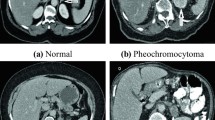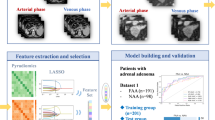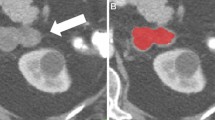Abstract
On adrenal glands, benign tumours generally change the hormone equilibrium, and malign tumours usually tend to spread to the nearby tissues and to the organs of the immune system. These features can give a trace about the type of adrenal tumours; however, they cannot be observed all the time. Different tumour types can be confused in terms of having a similar shape, size and intensity features on scans. To support the evaluation process, biopsy process is applied that includes injury and complication risks. In this study, we handle the binary characterisation of adrenal tumours by using dynamic computed tomography images. Concerning this, the usage of one more imaging modalities and biopsy process is wanted to be excluded. The used dataset consists of 8 subtypes of adrenal tumours, and it seemed as the worst-case scenario in which all handicaps are available against tumour classification. Histogram, grey level co-occurrence matrix and wavelet-based features are investigated to reveal the most effective one on the identification of adrenal tumours. Binary classification is proposed utilising four-promising algorithms that have proven oneself on the task of binary-medical pattern classification. For this purpose, optimised neural networks are examined using six dataset inspired by the aforementioned features, and an efficient framework is offered before the use of a biopsy. Accuracy, sensitivity, specificity, and AUC are used to evaluate the performance of classifiers. Consequently, malign/benign characterisation is performed by proposed framework, with success rates of 80.7%, 75%, 82.22% and 78.61% for the metrics, respectively.

Graphical abstract





Similar content being viewed by others
References
Ekeh AP, Walusimbi M, Brigham E, Woods RJ, McCarthy MC (2010) The prevalence of incidental findings on abdominal computed tomography scans of trauma patients. J Emerg Med 38:484–489
Zhao XJ, Pu JX (2010) The role of multislice helical CT in diagnosing small renal mass. In: 4th International Conference on Bioinformatics and Biomedical Engineering (ICBBE 2010), Chengdu, China, 2010. IEEE, pp 1–4
Hanna S, El-Kalioubie M, Badawy H, Halim M (2015) Optimal diagnosis of adrenal masses. Egypt J Radiol Nucl Med 46:511–520
Narang V, Sinha T, Sandhu AS, Karan SC, Srivastava A, Sethi GS, Talwar R, Prusty P, Kotwal N, Adlakha N, Aggarwale A (2009) Clinically inapparent bilateral adrenal masses due to histoplasmosis. Eur Urol 55:518–521
Goldenberg A, Rager J, Szczurek L, Sandau RL, Neff M (2011) Transabdominal laparoscopic adrenalectomy of a large adrenal lipoma: a case report and review of literature. Int J Surg Case Rep 2:172–174
Sun G, Dong X, Xu G (2006) Tumor tissue identification based on gene expression data using DWT feature extraction and PNN classifier. Neurocomputing 69:387–402
Dettori L, Semler L (2007) A comparison of wavelet, ridgelet, and curvelet-based texture classification algorithms in computed tomography. Comput Biol Med 37:486–498
Zhang SW, Huang DS, Wang SL (2010) A method of tumor classification based on wavelet packet transforms and neighborhood rough set. Comput Biol Med 40:430–437
Zhou S, Shi J, Zhu J, Cai Y, Wang R (2013) Shearlet-based texture feature extraction for classification of breast tumor in ultrasound image. Biomed Signal Proces 8:688–696
El-Dahshan ESA, Mohsen HM, Revett K, Salem ABM (2014) Computer-aided diagnosis of human brain tumor through MRI: a survey and a new algorithm. Expert Syst Appl 41:5526–5545
Muramatsu C, Hara T, Endo T, Fujita H (2016) Breast mass classification on mammograms using radial local ternary patterns. Comput Biol Med 72:43–53
Sahoo A, Chandra S (2017) Multi-objective grey wolf optimizer for improved cervix lesion classification. Appl Soft Comput 52:64–80
Biehl M, Schneider P, Smith DJ, Stiekema H, Taylor AE, Hughes BA, Shackleton CHL, Stewart PM, Arlt W (2012) Matrix relevance LVQ in steroid metabolomics based classification of adrenal tumors. In: 20th European Symposium on Artificial Neural Networks (ESANN 2012), Bruges, Belgium, 2012. pp 423–428
Saiprasad G, Chang CI, Safdar N, Saenz N, Siegel E (2013) Adrenal gland abnormality detection using random forest classification. J Digit Imaging 26:891–897
Li X, Guindani M, Ng CS, Hobbs BP (2017) Classification of adrenal lesions through spatial Bayesian modeling of GLCM. In: 2017 IEEE 14th International Symposium on Biomedical Imaging (ISBI 2017), Melbourne, Australia, 2017. IEEE, pp 147–151
Koyuncu H, Ceylan R (2017) Classification of adrenal lesions by bounded PSO-NN. In: 2017 25th Signal Processing and Communications Applications Conference (SIU 2017), Antalya, Turkey, 2017. IEEE, pp 1–4
Ceylan R, Koyuncu H (2016) A new breakpoint in hybrid particle swarm-neural network architecture: individual boundary adjustment. Int J Inf Tech Decis 15:1313–1343
Ceylan R, Koyuncu H (2017) A novel rotation forest modality based on hybrid NNs: RF (ScPSO-NN). J King Saud U – Comput Inf Sci. https://doi.org/10.1016/j.jksuci.2017.10.011
Koyuncu H, Ceylan R (2015) Scout particle swarm optimization. In: 6th European Conference of the International Federation for Medical and Biological Engineering (MBEC 2014), Dubrovnik, Croatia, 2015. Springer, pp 82–85
Karaboga D, Akay B (2009) A comparative study of artificial bee colony algorithm. Appl Math Comput 214:108–132
Koyuncu H, Ceylan R, Sivri M, Erdogan H (2017) An efficient pipeline for abdomen segmentation in CT images. J Digit Imaging 31:262–274. https://doi.org/10.1007/s10278-017-0032-0
Bevk M, Kononenko I (2002) A statistical approach to texture description of medical images: a preliminary study. In: Proceedings of the 15th IEEE Symposium on Computer-Based Medical Systems (CBMS 2002), Maribor, Slovenia, 2002. IEEE, pp 239–244
Hsieh KLC, Lo CM, Hsiao CJ (2017) Computer-aided grading of gliomas based on local and global MRI features. Comput Meth Prog Bio 139:31–38
Acknowledgments
This work is supported by the Coordinatorship of Konya Technical University’s Scientific Research Projects.
Author information
Authors and Affiliations
Corresponding author
Ethics declarations
Conflict of interest
The authors declare that they have no conflict of interest.
Ethical approval
All procedures performed in studies involving human participants were in accordance with the ethical standards of the institutional and/or national research committee and with the 1964 Helsinki declaration and its later amendments or comparable ethical standards.
Informed consent
Informed consent was obtained from all individual participants included in the study.
Additional information
Highlights
• Different types of adrenal tumours can include similar features (i.e., intensity, size, shape), while same-kind tumours can involve different features.
• Related to handicaps, a framework including robust feature extraction and classification methods is needed to categorize adrenal tumours.
• Histogram, grey level co-occurrence matrix and wavelet-based features are examined to reveal the most effective one.
• Binary classification of adrenal tumours is proposed utilising four-promising algorithms that have proven oneself on the task of binary-medical pattern classification.
• As a result, malign/benign characterisation is performed by proposed framework achieving remarkable accuracy, sensitivity, specificity and AUC rates.
• In tumour classification, a framework handling all visual handicaps is designed, and this study can be extended to the classification of tumours revealing on different organs.
Rights and permissions
About this article
Cite this article
Koyuncu, H., Ceylan, R., Asoglu, S. et al. An extensive study for binary characterisation of adrenal tumours. Med Biol Eng Comput 57, 849–862 (2019). https://doi.org/10.1007/s11517-018-1923-z
Received:
Accepted:
Published:
Issue Date:
DOI: https://doi.org/10.1007/s11517-018-1923-z




